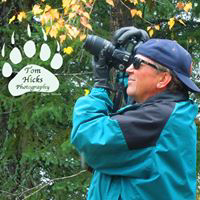The Pitfalls of Long Lenses and the Inexperienced Photographer
Jul 12, 2020 10:33:33 #
<<Not trying to be ornery but motion blur is not affected in any way by image stabilization. >>
That depends on motion being subject, or camera. IS helps only with CAMERA motion.
That depends on motion being subject, or camera. IS helps only with CAMERA motion.
Jul 12, 2020 10:35:13 #
"Not trying to be ornery but motion blur is not affected in any way by image stabilization".
That depends on motion being subject, or camera. IS helps only with CAMERA motion
That depends on motion being subject, or camera. IS helps only with CAMERA motion
Jul 12, 2020 10:38:34 #
Jul 12, 2020 10:49:45 #
olemikey
Loc: 6 mile creek, Spacecoast Florida
JohnH3 wrote:
I want to preface this post. It is primarily inten... (show quote)
You did a good job with your article, and it should help those who need it, and it should be appreciated (at the very minimum) for the effort and information. I appreciate your effort, but don't be surprised if you get more than just good feedback. I too like more than just the eyes in focus - I want the whole bird, cat/dog, bear, person, etc. in sharp focus, if possible. Again, good job!
Jul 12, 2020 11:04:52 #
olemikey wrote:
You did a good job with your article, and it should help those who need it, and it should be appreciated (at the very minimum) for the effort and information. I appreciate your effort, but don't be surprised if you get more than just good feedback. I too like more than just the eyes in focus - I want the whole bird, cat/dog, bear, person, etc. in sharp focus, if possible. Again, good job!
Thank you! I have no illusions that some will not rip it to threads! 😜
Jul 12, 2020 11:07:36 #
JohnH3 wrote:
I want to preface this post. It is primarily intended for an inexperienced long lens or macro user. .
Thank you for taking the time to make your post. I think you've hit the nail on the head for a lot of us. Just like a lot of others, I'm sure, I thought I knew and was applying the basics of getting sharp pictures. But like another member posted, I got a Nikon 500PF. At first I thought that I had gotten a bad copy until I realized that the softness in my images was too intermittent to be the fault of the lens. Technique was my true problem. Your post is a great reminder for those of us who have become lax or have newly acquired our first longer lenses.
Thanks again for taking the time!
Jul 12, 2020 11:13:42 #
bleirer wrote:
Not trying to be ornery but motion blur is not aff... (show quote)
Maybe I didn’t state it perfectly, but if you cannot use a tripod and you are using a long lens hand held at a slower than optimal shutter speed even if shooting a stationary object, isn’t camera shake, which is lessened by IS going to result in motion blur being potentially present in your image? It has been my experience that any camera shake at a slower shutter speed results is a less thsn crisp sharp image.
Jul 12, 2020 11:16:58 #
Every year of his legendary career, golfer Jack Nicklaus would begin his preparation for the upcoming tournament season by focusing with his teacher on grip, stance, alignment, setup and balance - even a practitioner of the art of golf at the highest levels of his game always came back to the the basics - thanks for the reminder - I know I could use a brush-up on technique now and then, and I appreciate your effort...
Jul 12, 2020 11:21:51 #
bleirer wrote:
Interesting information, but you have to consider ... (show quote)
Very true. I should have made mention of that fact. Thank you for pointing out that omission. Even though the depth of field is shallower with equivalent settings in the crop frame body, there is a remarkable difference in the shooting distance to obtain a similar image. Very good point.
Jul 12, 2020 11:48:37 #
John your very detailed yet comprehensive description is most appreciated! I know I handle my 100-400 much better at shutter speeds of at least 1/1000 and often go as high as 1/4000. I was struggling mightily with my 100 mm macro (on an 80d) until hearing from you. Haven’t mastered it yet but improving and happy. Thank you so much for this!
Marg
Marg
Jul 12, 2020 11:51:42 #
JohnH3 wrote:
Maybe I didn’t state it perfectly, but if you cannot use a tripod and you are using a long lens hand held at a slower than optimal shutter speed even if shooting a stationary object, isn’t camera shake, which is lessened by IS going to result in motion blur being potentially present in your image? It has been my experience that any camera shake at a slower shutter speed results is a less thsn crisp sharp image.
Yes you are correct, It seemed as if your IS statement included subject motion at first but then you clarified. Sure camera shake is motion, but in my mind I think of subject motion when someone says motion blur.
Jul 12, 2020 12:19:08 #
JohnH3 wrote:
I want to preface this post. It is primarily inten... (show quote)
Thank your for your post I was shooting birds yesterday at my 600 focal length and found only about 15% keepers I think this will definitely help
Jul 12, 2020 12:25:17 #
bleirer wrote:
Not trying to be ornery but motion blur is not aff... (show quote)
Just to be “ornery”, is camera “shake” not motion? We know that (photographically) there are 2 forms of motion either the subject moves or the camera / lens tip moves. Stabilization works to correct the second. Shutter speed will have an effect on both.😇
I’m sure all the readers knew what both of you meant.
Jul 12, 2020 13:13:48 #
JohnH3 wrote:
I want to preface this post. It is primarily inten... (show quote)
Thanks for sharing your insights ! ....should be valuable to most - IF - they take the time
Jul 12, 2020 13:16:31 #
bleirer wrote:
Yes you are correct, It seemed as if your IS statement included subject motion at first but then you clarified. Sure camera shake is motion, but in my mind I think of subject motion when someone says motion blur.
Camera shake/motion blur is my FIRST priority ....
If you want to reply, then register here. Registration is free and your account is created instantly, so you can post right away.




